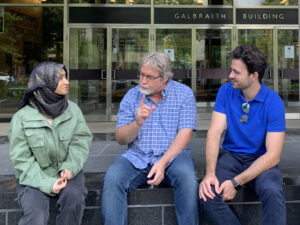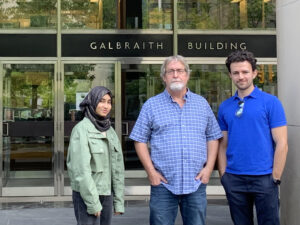Undergrad summer student research positions explored
The following is part of a series introducing CivMin’s undergraduate summer students to the Department and our greater community.
We explore the students’ projects, motivation and challenges, while providing insights into who they are, and what motivates them, beyond academia. It also highlights the multitude of ways summer research opportunities are approached and implemented under the guidance of our industry-leading CivMin professors.

Emaan Fatima (EngSci, Year 3) and Christopher Zuccaro (CivE 2T2 + PEY, MASc candidate), both in different stages of their educational journey, found an interest in water and energy systems. With a passion for equity-based research, Emaan hopes she can help people and make a difference. Christopher began Civil Engineering with the intent of becoming a civil engineer but once he took Professor Bryan Karney‘s course, CIV 250 – Hydraulics and Hydrology, he knew he wanted to pursue a future career involving the topic of water. This summer, Emaan and Christopher are both working as research students in CivMin, under the supervision of Prof. Karney.
Tell us a bit about yourself.
Emaan Fatima: I’m an Engineering Science [EngSci] student going into my third year, and I hope to do a PEY Co-op term. I was born in Canada, then we moved to the Middle East and lived there my entire life, moving back only for 12th grade. I live in Markham and have commuted every day for two years. I chose the energy systems option for my degree and that’s why I’m doing research with Prof. Karney.
Christopher Zuccaro: I just graduated from Civil Engineering here at the University of Toronto and will be pursuing a Master of Applied Science beginning in the upcoming term [September 2023]. I did my PEY Co-op at an engineering firm called HydraTek & Associates Inc., where I worked with Prof. Karney on a project exploring the potential correlation between rainfall IDF [intensity-duration-frequency] curves and climate change. I’m from Vaughan and commute to campus every day.
What will be your role this summer and where? What types of tasks and work will you be doing? What’s the research goal?
Emaan: I’m researching hydraulics and water power systems. I’m reviewing CIV401 [the course taught by Prof. Karney], which people in energy systems take in their fourth year. I’m going through lectures and writing notes and summaries. Prof. Karney is [providing me with] books and [other materials] related to dam failures, centred on the whole notion that any one mistake we make, as engineers, could have tragic consequences. My research is mostly on dam failures and applications of fluid mechanics. I’m also doing a lot of communications-focused extracurriculars this summer. I’m the VP of Communications this year for EngSci Club and I’m also part of publications, like The Toike and am working on the social media team for F!rosh Week 2T3.
Christopher: This summer, I’ll be working with Prof. Karney and the engineering firm, HydraTek, on a research project focusing on design criteria for sanitary system infrastructure. It seems the design values pertaining to rainfall derived inflow and infiltration (RDII) are not a very good representation of [what] is seen with real data. In addition, when the current values are applied between different jurisdictions and thus, different catchment sizes, there tends to be a discontinuity between design flows. Research in this topic will help give me a head start on my upcoming Master of Applied Science [MASc] thesis and will also put me on the path to becoming an expert in the field.
I want to work towards something that makes a difference, even if it’s small.
What motivated you to work with Prof. Karney on this project?
Emaan: I’ve been really interested in equity-based research. [I want] to help people with my degree and also [be] face-to-face with the people I help. When I looked up Prof. Karney, I discovered he founded a company in Vaughan [called Hydratek] related to hydropower. Initially, I wasn’t sure if hydro and water [systems] were exactly what I wanted to focus on but [Prof. Karney’s] main goal is to help people and make systems more efficient, which is what I want to do. I want to work towards something that makes a difference, even if it’s small.
Christopher: It started in second year when I was in Prof. Karney’s CIV 250 [Hydraulics and Hydrology] course. Up until then, I was determined to become a structural engineer, which all started when I was a kid. I used to be a big fan of the show, Bob the Builder, and when I asked my dad, “Hey, what’s Bob the Builder,” he said, “That’s a civil engineer.” Smart man. So, I came to university wanting to become a structural engineer, until I took Prof. Karney’s course. I found the topic of water much more interesting and immediately decided that I didn’t want to be a structural engineer anymore. I then made the connection with Prof. Karney and applied to his company for a summer job. From there, the summer position turned into a PEY co-op, which will eventually turn into a full-time position upon completion of my master’s degree. I haven’t looked back since.
What do you foresee being your greatest challenge?
Emaan: [Prof. Karney] wants me to do a bit of graphic design – make some sketches and graphics related to his lectures. I haven’t done graphics-related work for about two years. It will be a challenge to re-learn graphics software and communications techniques. I’m also used to making pretty and concise type graphics, but for this project, clarity is of utmost importance, which is one shift in mindset I’m going to have to focus on.
Christopher: The vast amount of information out there to learn and how to determine what is relevant, what is not, where to look for credible information, and then how to organize all this into a tangible topic that you can become confident with and speak to a large group about. There are lots of journals, lots of theses from past master’s and PhD students, and textbooks too. Statistics is another challenge. Although I understand it well, there is still so much more to learn that I can see benefiting me for both my upcoming master’s and my professional career.
Have you found any favourite spots on campus?
Emaan: In terms of study spots – Myhal, fourth floor, near the lockers, there are desks – that’s one of my favourite study spots. Another one is the tables in the main lobby of GB [Galbraith Building]. It’s kind of crazy because before I even got this opportunity, I was just sitting there, and Prof. Karney tried to come in, but the door was locked and I got up to open it. I didn’t know it was him at the time, but he recognized me later. In terms of fun spots – The Pit [Sanford Fleming Atrium] is great. The EngSci Common Room is also great.
Christopher: I spent a lot of time over at Goldring Gym, that’s definitely one of my favourites. The pathway between the buildings in Knox College is also very nice. Great spot for grad pics!
Do you have any interesting hobbies or talents you’d like to share?
Emaan: I’m trying Second Cup for the first time today. I’m a huge Tim Hortons person typically.
Christopher: I have a black belt in karate, play the guitar and enjoy golfing.
Questions for Prof. Karney:
What do you hope for Chris and Emaan to achieve this summer? Takeaways?
Prof. Karney: To tell you that, I need to give you a little bit of my philosophy – my interests are very broad, so I want to do something with the summer students that overlaps with my interests but is very much aligned with theirs too. It’s about finding the sweet spot because if you love what you do, it doesn’t take discipline to do it. And I’m hoping for my students to find topics they enjoy and be self-motivated, so they achieve something that they know is good and they’re proud of. My agenda is broad enough that it can accommodate lots of different directions, but they’re both working in my main area which overlaps water and energy systems. I’m hoping they grow, they learn, and they have a good experience.
How will Chris and Emaan be contributing to this project/your research?
Prof. Karney: Most of my engineering work seeks to have real application and to make a difference in the way we do things. Chris’s work is very much in that domain. He’s going to be working with the regions of Vaughan, York and a variety of others to hopefully improve the way we design. For Emaan’s work – we’re getting near the end of my career, I’ve got endless recorded lectures, and lots of ideas I need to move towards a permanent document that will last longer than me. So [Emaan’s] working on lecture material that will help her but will also hopefully turn into a textbook before I fully retire.
Watching them develop and find that enthusiasm, be able to run with it, and learn is one of the greatest satisfactions that a person could have in their career.
Is there anything I haven’t asked you about you’d like to speak on? Final thoughts?
Prof. Karney: The glorious thing about U of T is we get students that are self-motivated and capable enough that you can give them significant challenges, and they can rise to those challenges. Watching them develop and find that enthusiasm, be able to run with it, and learn is one of the greatest satisfactions that a person could have in their career. Taking the topic that they don’t know and learning much more about it so they can get near, or even at, the frontier of knowledge in that area.

By Rachael Gallant
To read about more CivMin summer research students, go to https://civmin.utoronto.ca/introducing-civmins-ug-summer-research-students/